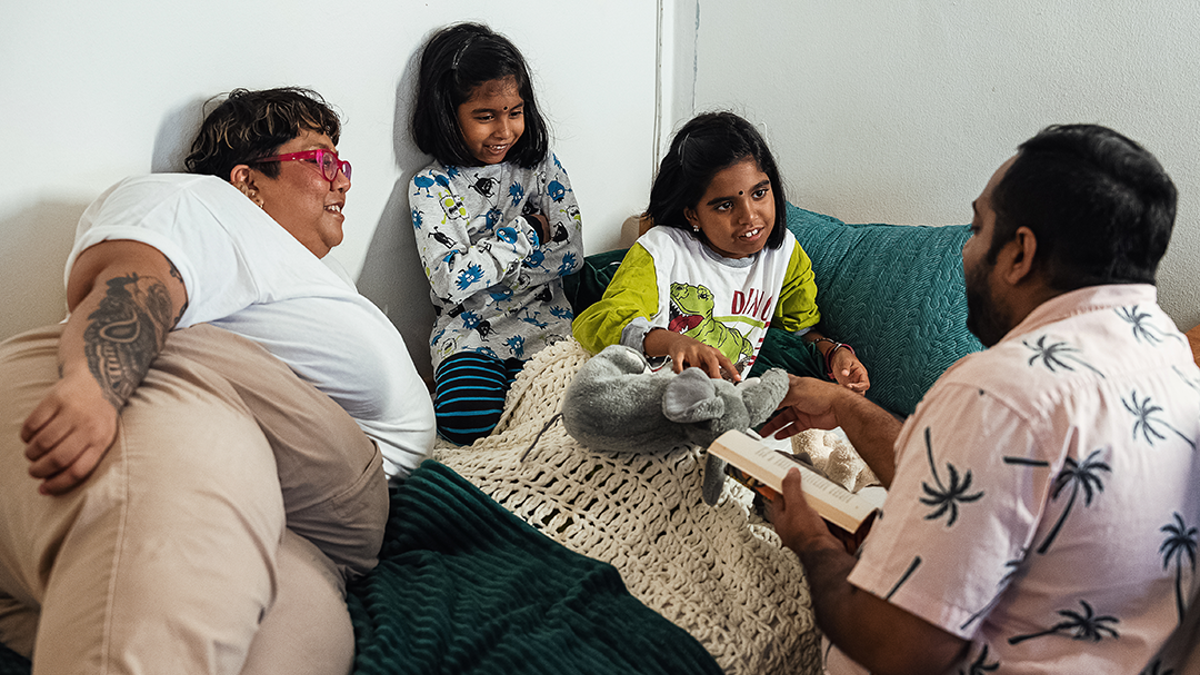Storytelling and narrative
- 5-11 Years
- 11-19 Years
- Child development and growing up
- Speech, language and communication

Learning to tell a story and sequence events are essential skills for children and teenagers to learn. It will help them understand the order of events and how to tell an engaging story. These stories can be from their imagination or repeating the events of the day.
Explore the topics on this page:
Arranging events in order (sequencing)
Storytelling
Storytelling is not just making up a story using your imagination. It can be retelling an event or experience. It is an important skill that will be helpful as your child develops and grows.
When children first start telling stories, it will sound like a lot of unrelated events. As this skill develops, your child will be able to organise information into events with characters, locations, and a plot.
Storytelling requires other skills that will develop at the same time. To tell a good story your child will use these skills:
- Understanding and use of grammar
- Known words (Vocabulary)
- Understanding cause and effect
- Understanding of a story structure
- Arranging events (sequencing)

There may be a difference between your child’s ability to tell a story verbally vs written. This will be because of their level in literacy skills. This is perfectly normal.
You can use short simple stories as an example for your child to learn more about storytelling. These can be picture book stories where you understand the information from the pictures.
To help your child tell a story you can talk to them about their story using the following questions:
- Who is in the story? For example, Rosie the Rabbit and Squeak the Squirrel.
- Where is the story located? For example, on the moon.
- When is the story set? For example, in medieval times with knights.
- What is the problem? For example, the characters have lost their favourite toy.
- How is the problem resolved? For example, the characters go on an adventure to find their favourite toy.
Arranging events in order (sequencing)
Arranging events in the order that they happen is called sequencing. Helping children learn how to arrange information in a specific order is an important skill.
You can use the activities to help your child understand the order of events. To start with, your child may find it easier to use a story they are familiar with like Goldilocks and the 3 Bears.
You will need:
Photos or pictures of the stages of a story. These can be handmade or printed out.
Visit All Kids Network for free printable resources,
The activity:
- Arrange pictures into the correct sequence order.
- Talk about each picture as it is placed.
- Go through the entire sequence, making sure to emphasise the order.
- Encourage your child to join in by repeating the sequence in order.
- Talk about the ‘first’ pictures or the ‘last thing that happened’.
- Encourage your child to find these pictures.
It is important that children understand the order of real events such as preparing to cook a meal. Try not to only use stories when teaching your child about sequencing.
When your child is more confident with sequencing events and understands words like ‘first’, ‘second’ and ‘last’, You can start to mix-up the order of the events. Encourage your child to reorder them in the correct order.
If your child is struggling with arranging events in order, you can help by:
- talking through the sequence many times
- giving them extra time to think about the events before they happen and to think about what happens after
- teaching them the meaning of ‘first’, ‘then’ and ‘last’
Helping your child understand language
Some children can struggle with:
- knowing what certain words mean
- understanding sentences and following instructions
- understanding how some words or saying can have more than one meaning
There are a variety of different ways to help your child better understand language.
By giving your child a choice, you can judge if your child has understood your question.
Things to keep in mind when giving your child choices:
- use words your child will understand
- name the choices you’re offering such as “Would you like orange juice or milk?”
- as your child understand more words, make your questions longer such as “Are you going home for lunch today or are you staying at school?”
Avoid asking yes/no questions. These do not encourage your child to talk. It is difficult to know if a child has understood the question.
You should always name the choices that you are offering for example “Would you like orange juice or milk?”
Naming, or labelling, is where you give an object a name for example “key” or “mummy”. There are many ways to encourage naming. Children need to hear a word a lot of times before they will be able to use it.
You can help by naming items or objects that your child points to or shows interest in. Make sure to repeat new words several times throughout the day in different situations. For example, if you are introducing the word ‘apple’ make sure to bring it up at snack time, when cooking and when you’re shopping.
There are a few activities and games you can do with your child to encourage naming:
Playing hide and seek. Hide pictures or objects around the room. Send your child to find them. Every time a picture or object is found, they must tell you what the object is.
Using a feely bag. Create a feely bag with lots of objects with interesting textures and surfaces. Pull toys from the bag 1 at a time and encourage your child to name them. If your child doesn’t know the name of the toy, say it for them.
Playing a game where you are ‘shopping’ for items. You can ask your child to point at the item you’re asking for.
Playing a fishing game. For the fishpond use a large empty container like a washing up bowl. Make some fish out of cardboard, stick some pictures of different objects onto the fish and attach paperclips to them. Make a fishing rod using a stick, string and a magnet. The magnet will attract the fish. When your child catches a fish, they need to name what is on the picture. If they answer correctly they can keep the fish.
Children can quickly learn how to properly form sentences when you repeat your child’s words back to them with the correct adult grammar. You can also add extra words into these sentences to help them learn more words. Children learn more from conversation with information about what is happening.
Use the same language in your everyday routines to instruct your child. This will help your child understand that the words are associated with those actions. For example, at bath time you can give the same instructions everyday such as “Let’s wash your face. Wash your arms. Now, let’s wash your hands.”
Accept unclear words without pointing them out or directly correcting them. Repeat the sentence back to your child clearly with the correct word. For example, they say “the dwass is wet.”. You should response with “Yes, the grass is wet.”
Try to keep your sentences simple. You can slowly add more words to what your child says to you, to help them learn more. For example, if your child says “bus.” then you could say “Yes, it’s a big green bus!”. Or if your child says “I fall down”, you can reply “Oh dear! You’ve fallen down and hurt your knee.”
Make sure to listen to your child so when they do speak or say a word, you can praise them. It does not matter if you cannot understand them completely or if their words are correctly pronounced.
Talking as you walk is a great way to introduce your child to new words. Walk slowly and take your time to look around you. Comment on what you see and hear. Notice the little things like bugs and grass as well as big things like buses and buildings.
For example, if a bus is passing on the road you could say “Wow, here comes a big bus. It’s full of people. Lots of mummies and daddies…”
It will help your child if you are excited to look at the world around you. They will also take an interest in it.
Comprehension skills
Comprehension skills are the skills used to understand spoken, non-spoken and written communication.
Children should be encouraged to be aware of their understanding of words and sentences. They should be able to know when they have or have not understood an instruction, question, or sentence.
If your child can identify what or why they don’t understand, they can ask the speaker to explain what they mean. There are many reasons a child can’t understand for example:
“I don’t know what a patella is.”
“I couldn’t hear what you said, the lawnmower was going past.”
“Can you say it in a simpler way?”
There are a few strategies that may help your child understand easier:
Using visual reminders – these can help your child understand the order of events and activities.
Taking notes – this can help prompt or remind your child of important information. Notetaking will also help them when they become an adult as well.
Mental pictures – some children find picturing the situation or activity in their mind helpful. It may help them to close their eyes as they picture what is happening. This is especially useful when telling stories.

You can also play barrier games with your child to help with comprehension and understanding language. Read our information on barrier games.
Last reviewed: 1 November, 2023
